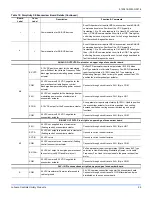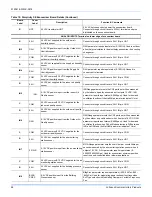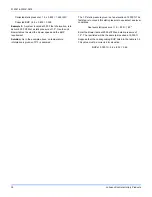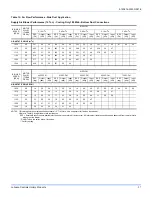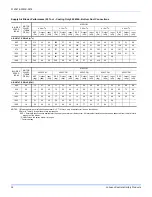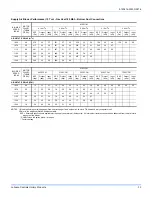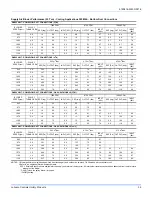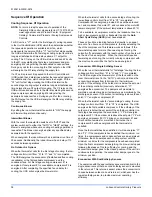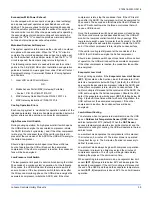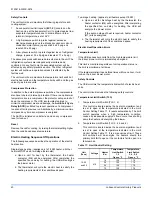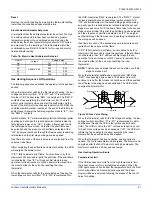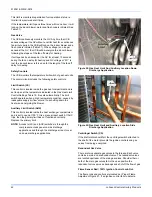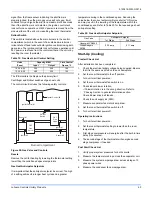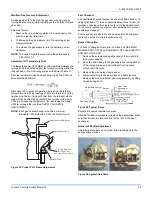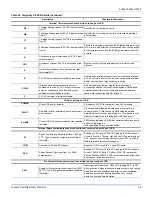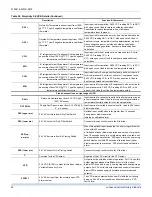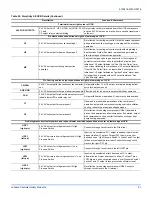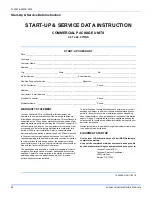
5120416-XIM-C-0216
Johnson Controls Unitary Products
39
Economizer With Power Exhaust
A unit equipped with an economizer (single or dual enthalpy)
and a power exhaust operates as specified above with one
addition. The power exhaust motor is energized 45 seconds
after the actuator position exceeds the exhaust fan set point on
the economizer control. When the power exhaust is operating,
the second stage of mechanical cooling will not operate. As
always, the "R" to "G" connection provides minimum position
but does not provide power exhaust operation.
Motorized Outdoor Air Dampers
This system operation is the same as the units with no outdoor
air options with one exception. When the “R” to “G” circuit is
complete, the motorized damper drives open to a position set
by the thumbwheel on the damper motor. When the “R” to “G”
circuit is opened, the damper spring returns fully closed.
The following components are needed to access the control
points in the
Simplicity
® SE control. Installation and operation
guides are located on www.upgnet.com under Product Center \
Equipment Catalog \ Commercial Products \ Zoning Systems
and Controls.
1.
Local LCD on Unit Control Board.
OR
2.
Mobile Access Portal (MAP) Gateway (Portable).
• Source 1 P/N S1-JC-MAP1810-OP
3.
MAP Gateway Quick Start Guide P/N 24-10737-16
4.
MAP Gateway Instruction P/N 24-10737-8
Cooling Operation Errors
Each cooling system is monitored for operation outside of the
intended parameters. Errors are handled as described below. All
system errors override minimum run times for compressors.
High-Pressure Limit Switch
During cooling operation, if a high-pressure limit switch opens,
the UCB will de-energize the associated compressor, initiate
the ASCD (Anti-short cycle delay), and, if the other compressor
is idle, stop the condenser fans. If the call for cooling is still
present at the conclusion of the ASCD, the UCB will re-energize
the halted compressor.
Should a high-pressure switch open three times within two
hours of operation, the UCB will lock-out the associated
compressor. If the other compressor is inactive, the condenser
fans will be de-energized.
Low-Pressure Limit Switch
The low-pressure limit switch is not monitored during the initial
30 seconds of a cooling system's operation. For the following
30 seconds, the UCB will monitor the low-pressure switch to
ensure it closes. If the low-pressure switch fails to close after
the 30-second monitoring phase, the UCB will de-energize the
associated compressor, initiate the ASCD, and, if the other
compressor is idle, stop the condenser fans. If the LPS is still
open after the ASCD, the compressor will not be energized for
30 seconds. The second and third times that the UCB sees an
open LPS will count towards the three occurrences that will
cause a UCB lock-out.
Once the low-pressure switch has been proven (closed during
the 30-second monitor period described above), the UCB will
monitor the low-pressure limit switch for any openings. If the
low-pressure switch opens for greater than 5 seconds, the UCB
will de-energize the associated compressor, initiate the ASCD,
and, if the other compressor is idle, stop the condenser fans.
If the call for cooling is still present at the conclusion of the
ASCD, the UCB will re-energize the halted compressor.
Should a low-pressure switch open three times within one hour
of operation, the UCB will lock-out the associated compressor.
If the other compressor is inactive, the condenser fans will be
de-energized.
Evaporator Low Limit
During cooling operation, if the
Evaporator Low Limit Sensor
(EC1, 2)
(Located on the Suction Line at the Evaporator Coil.)
detects a temperature below 26 Deg. F (default), the UCB will
de-energize the associated compressor, initiate the ASCD, and,
if the other compressor is idle, stop the condenser fans. If the
call for cooling is still present at the conclusion of the ASCD, the
UCB will re-energize the halted compressor. Should the UCB
detect the evaporator low limit sensor
(EC1, 2)
falling below 26
Deg. F (default) three times within two hours of operation, the
UCB will lock-out the associated compressor. If the other
compressor is inactive, the condenser fans will be de-
energized.
Low Ambient Cooling
To determine when to operate in low ambient mode, the UCB
has an
Outdoor Air Temperature Sensor (OAT)
with a low
ambient setpoint at 45ºF (default). When the
OAT Sensor
senses a temperature below the low ambient setpoint and the
thermostat is calling for cooling, the UCB will operate in the low
ambient mode.
Low ambient mode operates the compressors in this manner:
10 minutes on, 5 minutes off. The indoor blower is operated
throughout the cycle. The 5-minute off period is necessary to
defrost the indoor coil.
Low ambient mode always begins with compressor operation.
Compressor minimum run time may extend the minutes of
compressor operation. The off cycle will begin immediately
following the elapse of the minimum run time.
When operating in low ambient mode, an evaporator low limit
sensor
(EC1, 2)
temperature below 26ºF will de-energize the
associated compressor. If the call for cooling is still present at
the end of the ASCD and the and the evaporator temperature
sensor
(EC1, 2)
temperature is above 26°F, the unit will resume
operation.

